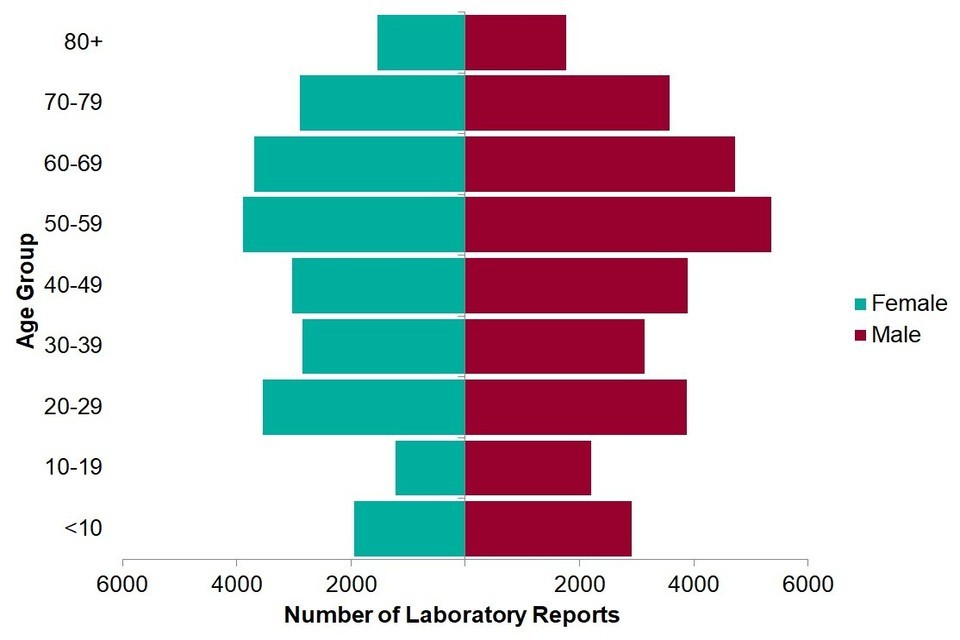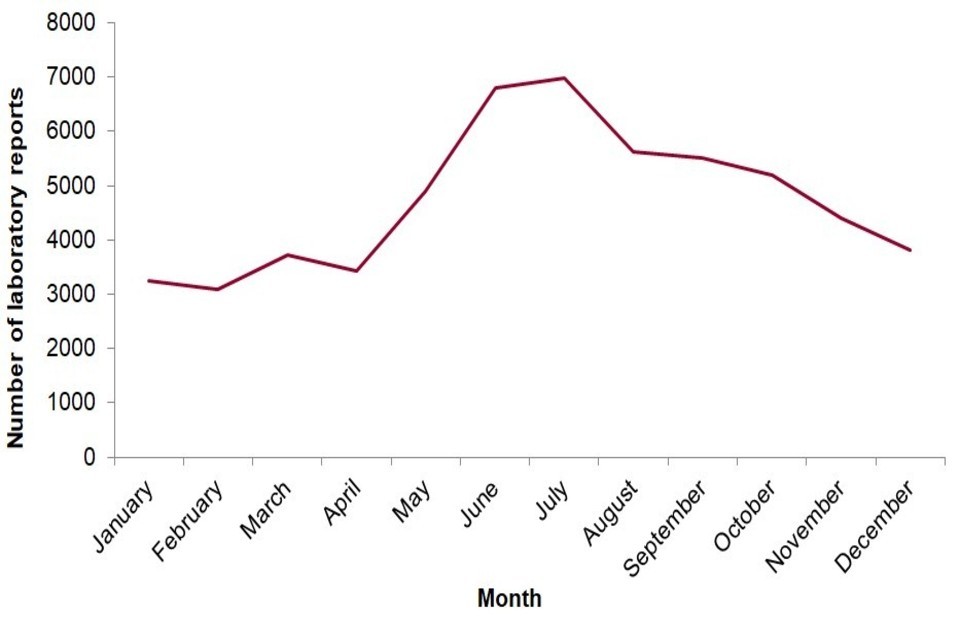Campylobacter data 2008 to 2017
Updated 26 June 2025
Main points for 2017
The reported number of cases increased from 52,381 in 2016 to 56,729 in 2017, an increase of 4,348 cases.
The region that reported the highest number of Campylobacter laboratory reports was the South East with 10,553.
Overall, 56% of Campylobacter laboratory-confirmed cases in England and Wales were male.
The section of the population with the highest number of laboratory reports was the 50 to 59 year age group.
The peak month for Campylobacter reporting in 2017 was July.
Campylobacter data, 2008 to 2017
All data presented in this report are correct as of 30 July 2018.
Annual data: 2008 to 2017
Table 1: Annual laboratory reports of Campylobacter in England and Wales (2008 to 2017)
| Year | Number | Per 100,000 population |
|---|---|---|
| 2008 | 49,891 | 90.97 |
| 2009 | 57,685 | 104.44 |
| 2010 | 62,588 | 112.38 |
| 2011 | 64,527 | 114.88 |
| 2012 | 65,044 | 114.98 |
| 2013 | 59,040 | 103.67 |
| 2014 | 62,494 | 108.86 |
| 2015 | 55,697 | 96.22 |
| 2016 | 52,381 | 89.72 |
| 2017 | 56,729 | 96.57 |
Figure 1: Annual laboratory reports of Campylobacter in England and Wales (2008 to 2017)

Regional data: 2017
Table 2: Regional distribution[footnote 1] of laboratory reports of Campylobacter in England and Wales (2017)
| Country | Region | Laboratory reports |
|---|---|---|
| England | East Midlands | 4,073 |
| England | East of England | 5,776 |
| England | London | 5,488 |
| England | North East | 3,242 |
| England | North West | 6,874 |
| England | South East | 10,553 |
| England | South West | 6,486 |
| England | Yorkshire and The Humber | 5,255 |
| England | West Midlands | 5,321 |
| Wales | Wales | 3,661 |
Age or sex distribution: 2017
Figure 2: Age or sex distribution of laboratory reports of Campylobacter reported in England and Wales (2017).

Seasonal variation: 2017
Figure 3: Seasonality of laboratory reports of Campylobacter reported in England and Wales (2017).

Foodborne outbreak data (2017)
Table 3: Foodborne outbreaks of Campylobacter reported in England and Wales (2017).
| Agent | Total Affected | Laboratory confirmed | Hospitalised | Deaths | Setting | Food description |
|---|---|---|---|---|---|---|
| Campylobacter sp. | 8 | 6 | 3 | 0 | Hotel | Chicken liver parfait |
| Campylobacter sp. | 16 | 4 | 1 | 0 | Pub/Bar | Chicken liver pate |
| Campylobacter sp. | 5 | 5 | 0 | 0 | Farm | Raw Drinking Milk |
| Campylobacter sp. | 9 | 5 | 2 | 0 | School | Chicken |
| Campylobacter sp. | 4 | 4 | 0 | 0 | Farm | Raw Drinking Milk |
| Campylobacter sp. | 26 | 2 | 2 | 0 | Private event | Duck liver pate |
| Campylobacter sp. | 52 | 7 | 1 | 0 | Hotel | Chicken liver pate |
| Campylobacter sp. | 13 | 2 | 0 | 0 | Private event | Chicken liver parfait |
| Campylobacter sp | 13 | 4 | 0 | 0 | Hotel | Chicken liver parfait |
Data sources
Data sources include:
-
Public Health England (PHE)’s Second Generation Surveillance System (SGSS) was used for England Campylobacter data; this is a live laboratory reporting system, therefore, numbers are subject to change
-
in 2014, PHE upgraded the laboratory reporting system so direct comparisons between data reported from the previous system (LabBase2) and the new system (SGSS) may require cautious interpretation
-
Welsh data has been provided by Public Health Wales
-
Electronic foodborne and non-foodborne gastrointestinal outbreak surveillance system (eFOSS)
Acknowledgements
We are grateful to:
- microbiologists, local authorities, health protection and environmental health specialists who have contributed data and reports to national surveillance systems
- epidemiologists and information officers who have worked on the national surveillance of intestinal infectious diseases
- the Gastrointestinal Bacterial Reference Unit (GBRU) for providing the Reference Laboratory Services and laboratory surveillance functions and expertise
- the PHE Information Management Department for maintenance and quality assurance of PHE national surveillance databases used for Gastrointestinal Infections (GI) pathogen surveillance at the national level
- the PHE Local Public Health Laboratories and Food Water and Environmental Microbiology Services for providing a surveillance function for GI pathogens and testing of food and environmental samples routinely and during outbreak investigations
- all colleagues who have investigated and reported outbreaks to the Electronic Foodborne and Non-Foodborne Gastrointestinal Outbreak Surveillance System (eFOSS)
PHE has a statutory obligation to collect and report outbreaks of foodborne disease. This is aligned to the requirements of the zoonoses directive 2003/99/EC. This directive requires that EU member states investigate and report all foodborne outbreaks to the European Food Safety Authority (EFSA).
Additionally, information on other zoonotic disease outbreaks is included in eFOSS, such as non-foodborne outbreaks (mode of transmission covering animal contact, person to person contact and recreational water).
-
regional classification based on place of residence of reported cases and classified using NUTS1 codes. ↩
